Page 337 of 409
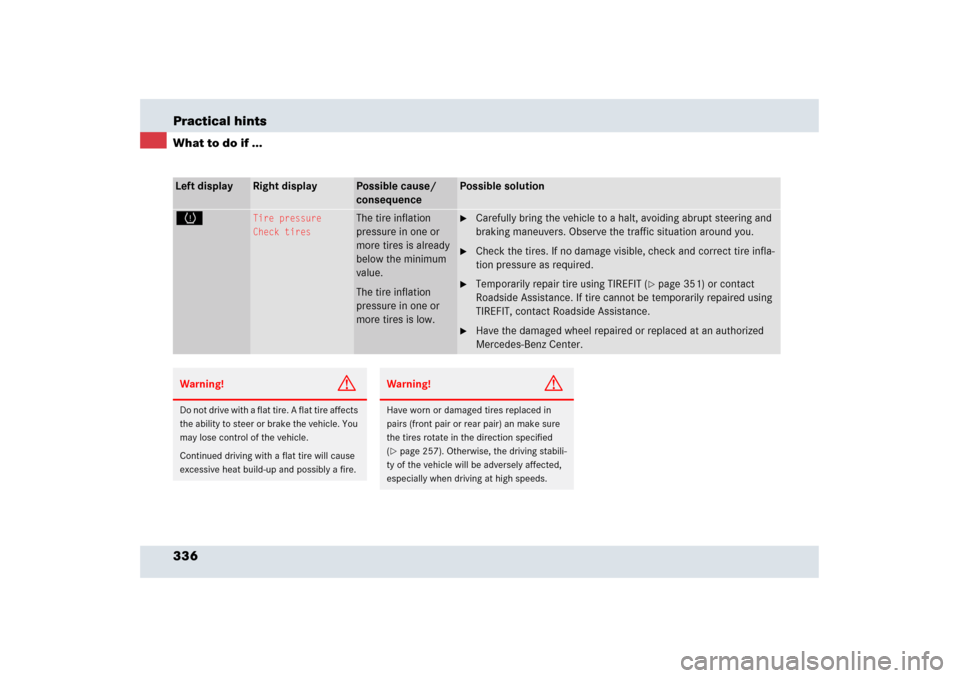
336 Practical hintsWhat to do if ...Left display
Right display
Possible cause/
consequence
Possible solution
H
Tire pressure
Check tires
The tire inflation
pressure in one or
more tires is already
below the minimum
value.
The tire inflation
pressure in one or
more tires is low.
�
Carefully bring the vehicle to a halt, avoiding abrupt steering and
braking maneuvers. Observe the traffic situation around you.
�
Check the tires. If no damage visible, check and correct tire infla-
tion pressure as required.
�
Temporarily repair tire using TIREFIT (
�page 351) or contact
Roadside Assistance. If tire cannot be temporarily repaired using
TIREFIT, contact Roadside Assistance.
�
Have the damaged wheel repaired or replaced at an authorized
Mercedes-Benz Center.
Warning!
G
Do not drive with a flat tire. A flat tire affects
the ability to steer or brake the vehicle. You
may lose control of the vehicle.
Continued driving with a flat tire will cause
excessive heat build-up and possibly a fire.
Warning!
G
Have worn or damaged tires replaced in
pairs (front pair or rear pair) an make sure
the tires rotate in the direction specified
(�page 257). Otherwise, the driving stabili-
ty of the vehicle will be adversely affected,
especially when driving at high speeds.
Page 338 of 409

337 Practical hints
What to do if ...
Left display
Right display
Possible cause/
consequence
Possible solution
H
Tire pressure, FL
Caution
Tire defect
The left front tire is
deflating.
�
Carefully bring the vehicle to a halt, avoiding abrupt steering and
braking maneuvers. Observe the traffic situation around you.
�
Temporarily repair tire using TIREFIT (
�page 351) or contact
Roadside Assistance. If tire cannot be temporarily repaired using
TIREFIT, contact Roadside Assistance.
�
Have the damaged wheel repaired or replaced at an authorized
Mercedes-Benz Center.
Tire pressure, FL
Check
tires
The left front tire in-
flation pressure is
low.
�
Carefully bring the vehicle to a halt.
�
Check the tires. If no damage visible, check and correct tire infla-
tion pressure as required.
�
If necessary, have the wheel repaired or replaced at an authorized
Mercedes-Benz Center.
Warning!
G
Do not drive with a flat tire. A flat tire affects
the ability to steer or brake the vehicle. You
may lose control of the vehicle.
Continued driving with a flat tire will cause
excessive heat build-up and possibly a fire.
Warning!
G
Have worn or damaged tires replaced in
pairs (front pair or rear pair) an make sure
the tires rotate in the direction specified
(�page 257).
Otherwise, the driving stability of the vehicle
will be adversely affected, especially when
driving at high speeds.
Page 339 of 409
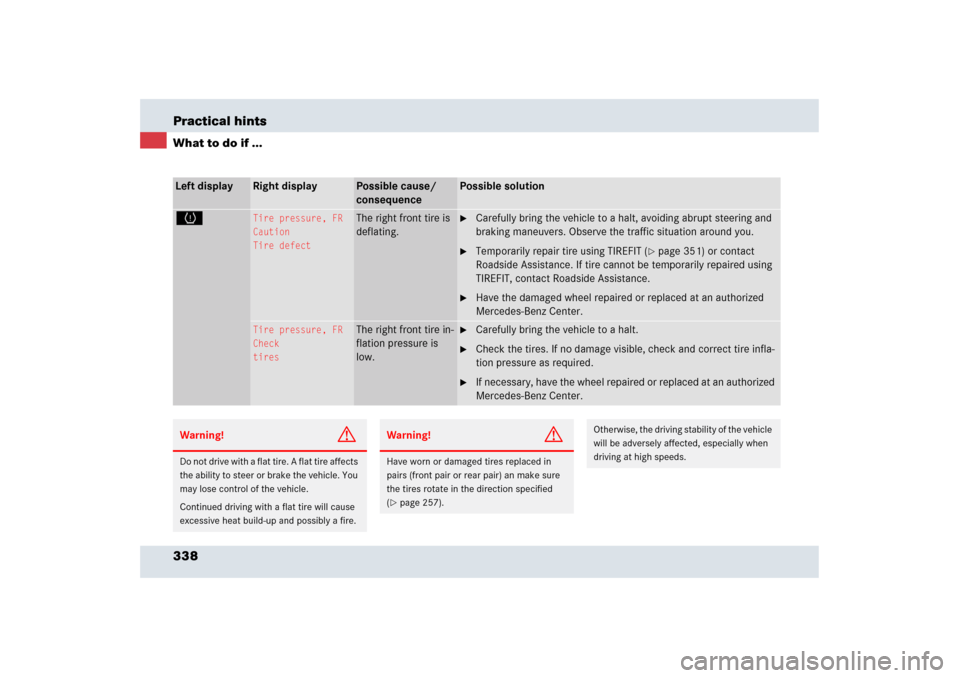
338 Practical hintsWhat to do if ...Left display
Right display
Possible cause/
consequence
Possible solution
H
Tire pressure, FR
Caution
Tire defect
The right front tire is
deflating.
�
Carefully bring the vehicle to a halt, avoiding abrupt steering and
braking maneuvers. Observe the traffic situation around you.
�
Temporarily repair tire using TIREFIT (
�page 351) or contact
Roadside Assistance. If tire cannot be temporarily repaired using
TIREFIT, contact Roadside Assistance.
�
Have the damaged wheel repaired or replaced at an authorized
Mercedes-Benz Center.
Tire pressure, FR
Check
tires
The right front tire in-
flation pressure is
low.
�
Carefully bring the vehicle to a halt.
�
Check the tires. If no damage visible, check and correct tire infla-
tion pressure as required.
�
If necessary, have the wheel repaired or replaced at an authorized
Mercedes-Benz Center.
Warning!
G
Do not drive with a flat tire. A flat tire affects
the ability to steer or brake the vehicle. You
may lose control of the vehicle.
Continued driving with a flat tire will cause
excessive heat build-up and possibly a fire.
Warning!
G
Have worn or damaged tires replaced in
pairs (front pair or rear pair) an make sure
the tires rotate in the direction specified
(�page 257).
Otherwise, the driving stability of the vehicle
will be adversely affected, especially when
driving at high speeds.
Page 340 of 409
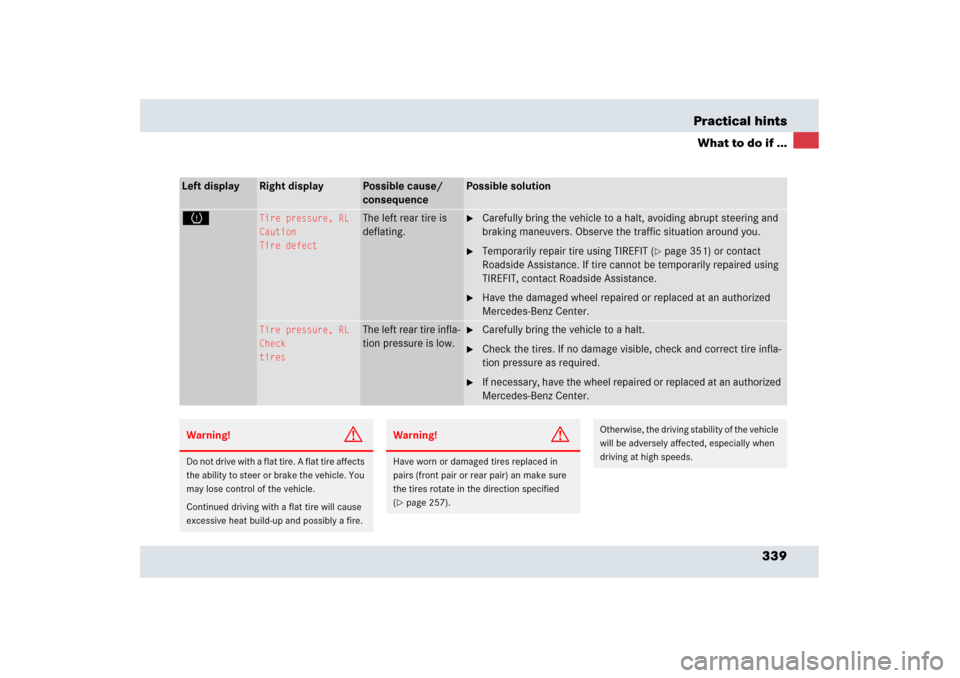
339 Practical hints
What to do if ...
Left display
Right display
Possible cause/
consequence
Possible solution
H
Tire pressure, RL
Caution
Tire defect
The left rear tire is
deflating.
�
Carefully bring the vehicle to a halt, avoiding abrupt steering and
braking maneuvers. Observe the traffic situation around you.
�
Temporarily repair tire using TIREFIT (
�page 351) or contact
Roadside Assistance. If tire cannot be temporarily repaired using
TIREFIT, contact Roadside Assistance.
�
Have the damaged wheel repaired or replaced at an authorized
Mercedes-Benz Center.
Tire pressure, RL
Check
tires
The left rear tire infla-
tion pressure is low.
�
Carefully bring the vehicle to a halt.
�
Check the tires. If no damage visible, check and correct tire infla-
tion pressure as required.
�
If necessary, have the wheel repaired or replaced at an authorized
Mercedes-Benz Center.
Warning!
G
Do not drive with a flat tire. A flat tire affects
the ability to steer or brake the vehicle. You
may lose control of the vehicle.
Continued driving with a flat tire will cause
excessive heat build-up and possibly a fire.
Warning!
G
Have worn or damaged tires replaced in
pairs (front pair or rear pair) an make sure
the tires rotate in the direction specified
(�page 257).
Otherwise, the driving stability of the vehicle
will be adversely affected, especially when
driving at high speeds.
Page 341 of 409
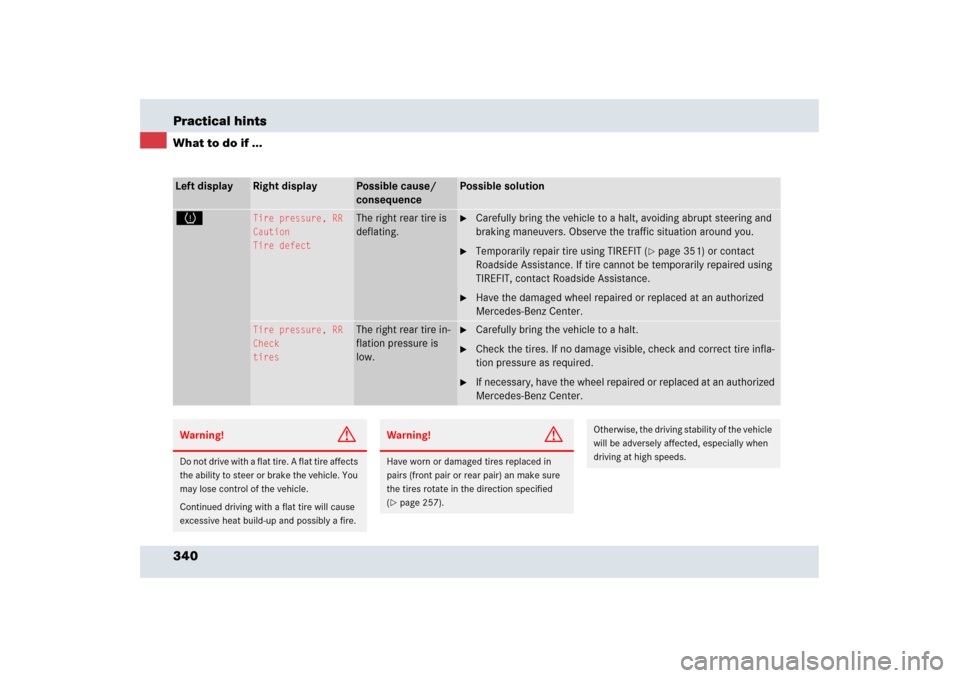
340 Practical hintsWhat to do if ...Left display
Right display
Possible cause/
consequence
Possible solution
H
Tire pressure, RR
Caution
Tire defect
The right rear tire is
deflating.
�
Carefully bring the vehicle to a halt, avoiding abrupt steering and
braking maneuvers. Observe the traffic situation around you.
�
Temporarily repair tire using TIREFIT (
�page 351) or contact
Roadside Assistance. If tire cannot be temporarily repaired using
TIREFIT, contact Roadside Assistance.
�
Have the damaged wheel repaired or replaced at an authorized
Mercedes-Benz Center.
Tire pressure, RR
Check
tires
The right rear tire in-
flation pressure is
low.
�
Carefully bring the vehicle to a halt.
�
Check the tires. If no damage visible, check and correct tire infla-
tion pressure as required.
�
If necessary, have the wheel repaired or replaced at an authorized
Mercedes-Benz Center.
Warning!
G
Do not drive with a flat tire. A flat tire affects
the ability to steer or brake the vehicle. You
may lose control of the vehicle.
Continued driving with a flat tire will cause
excessive heat build-up and possibly a fire.
Warning!
G
Have worn or damaged tires replaced in
pairs (front pair or rear pair) an make sure
the tires rotate in the direction specified
(�page 257).
Otherwise, the driving stability of the vehicle
will be adversely affected, especially when
driving at high speeds.
Page 342 of 409
341 Practical hints
What to do if ...
Left display
Right display
Possible cause/
consequence
Possible solution
Ê
Close
trunk lid
This message will appear when-
ever the trunk lid is open.
�
Close the trunk lid (
�page 101).
W
Washer fluid
Check level
The washer fluid level has
dropped to about
1/3 of total
reservoir capacity.
�
Add washer fluid (
�page 252).
Page 354 of 409
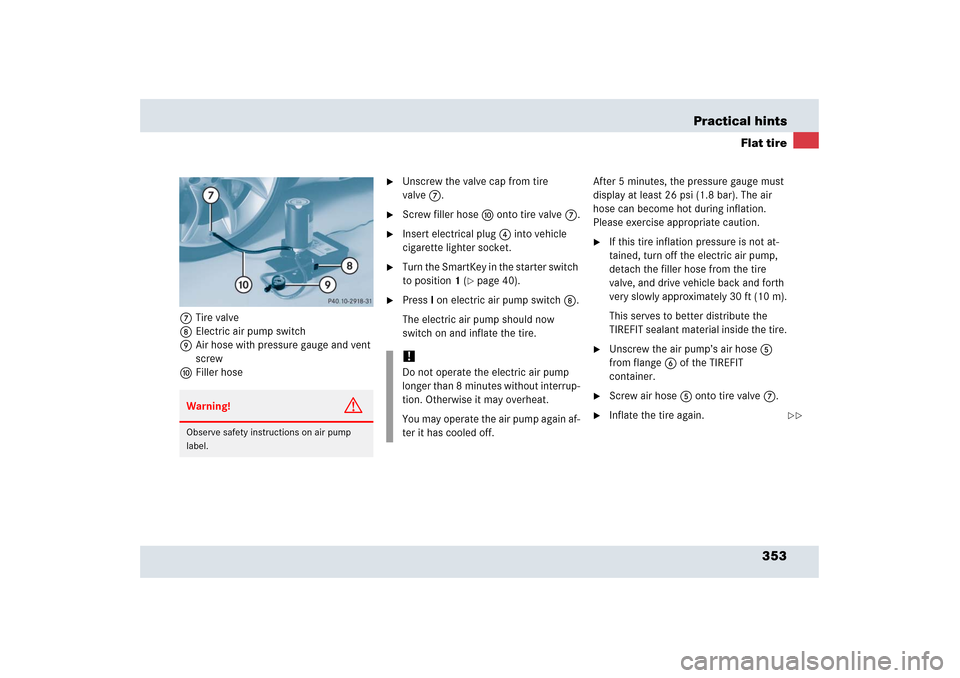
353 Practical hints
Flat tire
7Tire valve
8Electric air pump switch
9Air hose with pressure gauge and vent
screw
aFiller hose
�
Unscrew the valve cap from tire
valve7.
�
Screw filler hosea onto tire valve7.
�
Insert electrical plug4 into vehicle
cigarette lighter socket.
�
Turn the SmartKey in the starter switch
to position1 (
�page 40).
�
PressI on electric air pump switch8.
The electric air pump should now
switch on and inflate the tire.After 5 minutes, the pressure gauge must
display at least 26 psi (1.8 bar). The air
hose can become hot during inflation.
Please exercise appropriate caution.
�
If this tire inflation pressure is not at-
tained, turn off the electric air pump,
detach the filler hose from the tire
valve, and drive vehicle back and forth
very slowly approximately 30 ft (10 m).
This serves to better distribute the
TIREFIT sealant material inside the tire.
�
Unscrew the air pump’s air hose5
from flange6 of the TIREFIT
container.
�
Screw air hose5onto tire valve7.
�
Inflate the tire again.
Warning!
G
Observe safety instructions on air pump
label.
!Do not operate the electric air pump
longer than 8 minutes without interrup-
tion. Otherwise it may overheat.
You may operate the air pump again af-
ter it has cooled off.
��
Page 387 of 409

386 Technical termsCAN system
(C
ontroller A
rea N
etwork)
Data bus network serving to control ve-
hicle functions such as door locking or
windshield wiping depending on vehi-
cle settings and/or ambient condi-
tions.
Cockpit
All instruments, switches, buttons and
indicator/warning lamps in the passen-
ger compartment needed for vehicle
operation and monitoring.
Cold tire inflation pressure
(
�page 281)
Control system
The control system is used to call up
vehicle information and to change
component settings. Information and
messages appear in the multifunction
display. The driver uses the buttons on
the multifunction steering wheel to
navigate through the system and to ad-
just settings.Cruise control
Driving convenience system for auto-
matically maintaining the vehicle speed
set by the driver.
Curb weight
(
�page 281)
DOT
(Department o
f Transportation)
(
�page 282)
Engine number
The number set by the manufacturer
and placed on the cylinder block to
uniquely identify each engine pro-
duced.
Engine oil viscosity
Measure of the internal oil friction (vis-
cosity) at different temperatures. The
higher the temperature the oil can tol-
erate without thinning too much, or the
lower the temperature it can tolerate
without thickening too much, the bet-
ter the viscosity characteristics of the
oil.ESP
®(Eectronic S
tability P
rogram)
Improves vehicle handling and direc-
tional stability.
ETD
(E
mergency T
ensioning D
evice)
Device which deploys in certain frontal
and rear collisions exceeding the sys-
tem's threshold to tighten the seat
belts.
->SRS
GAWR
(G
ross A
xle W
eight R
ating)
(
�page 282)
Gear range
Number of gears which are available to
the automatic transmission for shifting.
The automatic gear shifting process
can be adapted to specific operating
conditions using the gear selector lever
or the steering wheel gearshift control
buttons.